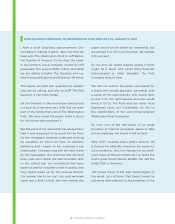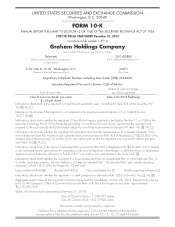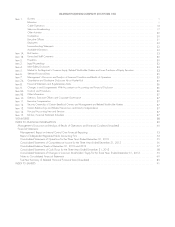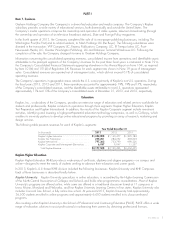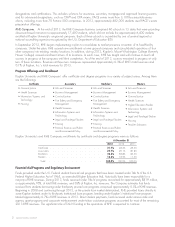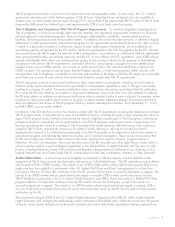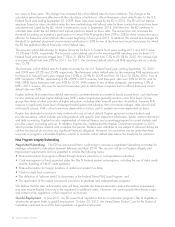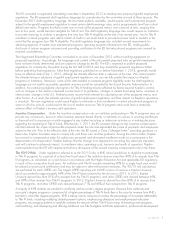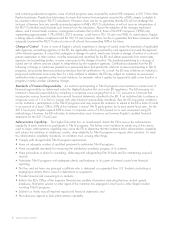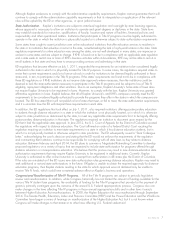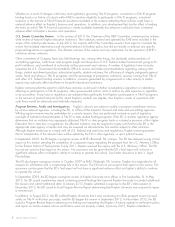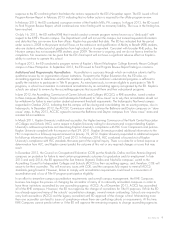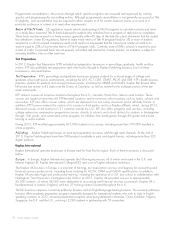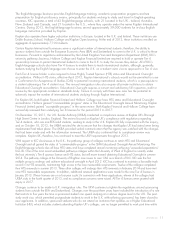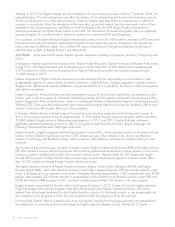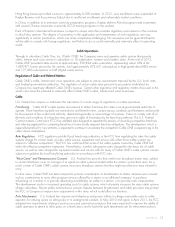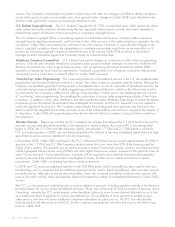Washington Post 2013 Annual Report Download - page 22
Download and view the complete annual report
Please find page 22 of the 2013 Washington Post annual report below. You can navigate through the pages in the report by either clicking on the pages listed below, or by using the keyword search tool below to find specific information within the annual report.two years to three years. This change has increased the cohort default rates for most institutions. The change to the
calculation period became effective with the calculation of institutions’ official three-year cohort default rates for the U.S.
Federal fiscal year ending September 30, 2009; those rates were issued by the ED in 2012. The ED will not impose
sanctions based on rates calculated under this new methodology until official rates for three consecutive years have been
calculated and issued by the ED, which is expected to occur in September 2014. Until that time, the ED continues to
calculate rates under the old method and impose sanctions based on those rates. The revised law also increases the
threshold for ending an institution’s participation in certain Title IV programs from 25% to 30% for three consecutive years,
effective for three-year cohort default rates issued beginning in fiscal year 2012. In addition, the revised law changes the
threshold for potential placement on provisional certification to 30% for two of the three most recent fiscal years for which
the ED has published official three-year cohort default rates.
The two-year cohort default rates for Kaplan University for the U.S. Federal fiscal years ending 2011 and 2010 were
15.3% and 16.8%, respectively. The two-year cohort default rates for the remaining KHE reporting units for those U.S.
Federal fiscal year periods ranged from 7.5% to 21.8% for 2011 and from 7.5% to 25.3% for 2010. No campus had
a two-year official rate over 25% for 2011. For 2011, the combined default rate for all KHE reporting units as a whole
was 15.7%.
The three-year cohort default rates for Kaplan University for the U.S. Federal fiscal years ending September 30, 2010
and 2009 were 26.2% and 25.9% respectively. The three-year cohort default rates for the remaining KHE reporting units
for those U.S. federal fiscal years ranged from 14.9% to 33.9% for 2009 and from 14.1% to 35.3% for 2010. Four of
KHE Campuses’ OPEIDs, representing 2.9% of KHE’s 2013 revenue, had three-year rates over 30% for 2010, and no
KHE OPEID had a three-year rate over 40% for 2010. With respect to two of these campuses, representing 1.4% of
KHE’s 2013 revenue, this was the second consecutive year in which these campuses had an official three-year cohort
default rate over 30%.
Kaplan believes that student loan default rates tend to correlate directly to a student’s family income level, such that lower
income students will have higher default rates. KHE’s student population generally tends to come from lower income
groups than those of other providers of higher education, including other for-profit providers. In addition, because KHE
receives a significantly lower level of taxpayer-funded grants and subsidies than community colleges, state schools and
not-for-profit schools, KHE’s schools are more dependent on tuition, and its students are more dependent on loans.
Kaplan has dedicated resources to help students who are at risk of default. Kaplan personnel contact students and
provide assistance, which includes providing students with specific loan repayment information, lender contact information
and debt counseling. Kaplan has also implemented a financial literacy and counseling program for current students and
provides career counseling services. In addition, Kaplan also implemented the Kaplan Commitment program in 2010,
which provides first-time students with a risk-free trial period. Students who withdraw or are subject to dismissal during the
risk-free trial period do not incur any significant financial obligation. However, no assurances can be given that these
resources or programs will enable Kaplan’s schools to maintain cohort default rates below the thresholds for sanctions.
New Program Integrity Rulemaking
Negotiated Rulemaking. The ED has announced that it is planning to convene a negotiated rulemaking committee for
meetings scheduled to take place between February and April 2014. The sessions will be on Program Integrity and
Improvement requirements and are expected to include the following topics:
• State authorization for programs offered through distance education or correspondence education;
• Cash management of funds provided under the Title IV Federal student aid programs, including the use of debit cards
and the handling of Title IV credit balances;
• State authorization for foreign locations of institutions located in a State;
• Clock to credit hour conversion;
• The definition of “adverse credit” for borrowers in the Federal Direct PLUS Loan Program; and
• The application of the repeat coursework provisions to graduate and undergraduate programs.
We believe that the state authorization rules will likely reinstate the distance-education state authorization requirements
and may require Kaplan University to be registered in additional states. However, we cannot predict the ultimate scope
and content of the regulations or their impact on our business.
Gainful Employment. In June 2011, the ED issued final regulations that tie an education program’s Title IV eligibility to
whether the program leads to gainful employment. On June 30, 2012, the United States District Court for the District of
Columbia overturned most of the final regulations on gainful employment.
4GRAHAM HOLDINGS COMPANY


